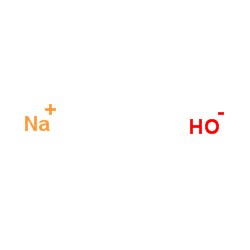Sodium hydroxide

Sodium hydroxide structure
|
Common Name | Sodium hydroxide | ||
|---|---|---|---|---|
| CAS Number | 1310-73-2 | Molecular Weight | 39.997 | |
| Density | 2.13 | Boiling Point | 1390 ºC | |
| Molecular Formula | HNaO | Melting Point | 318 ºC | |
| MSDS | Chinese USA | Flash Point | 176-178°C | |
| Symbol |

GHS05 |
Signal Word | Danger | |
| Name | Sodium hydroxide |
|---|---|
| Synonym | More Synonyms |
| Density | 2.13 |
|---|---|
| Boiling Point | 1390 ºC |
| Melting Point | 318 ºC |
| Molecular Formula | HNaO |
| Molecular Weight | 39.997 |
| Flash Point | 176-178°C |
| Exact Mass | 39.992512 |
| PSA | 23.06000 |
| Vapour density | <1 (vs air) |
| Vapour Pressure | 24.5mmHg at 25°C |
| Index of Refraction | 1.473-1.475 |
| Water Solubility | SOLUBLE |
CHEMICAL IDENTIFICATION
HEALTH HAZARD DATAACUTE TOXICITY DATA
MUTATION DATA
|
| Symbol |

GHS05 |
|---|---|
| Signal Word | Danger |
| Hazard Statements | H290-H314 |
| Precautionary Statements | P280-P303 + P361 + P353-P304 + P340 + P310-P305 + P351 + P338 |
| Personal Protective Equipment | Eyeshields;Faceshields;full-face particle respirator type N100 (US);Gloves;respirator cartridge type N100 (US);type P1 (EN143) respirator filter;type P3 (EN 143) respirator cartridges |
| Hazard Codes | C: Corrosive; |
| Risk Phrases | R35 |
| Safety Phrases | S26-S45-S37/39-S24/25-S36/37/39 |
| RIDADR | UN 1824 8/PG 2 |
| WGK Germany | 1 |
| RTECS | TT2975000 |
| Packaging Group | II |
| Hazard Class | 8 |
| HS Code | 2815110000 |
| HS Code | 2815110000 |
|---|
|
Aptamer-based polyvalent ligands for regulated cell attachment on the hydrogel surface.
Biomacromolecules 16(4) , 1382-9, (2015) Natural biomolecules are often used to functionalize materials to achieve desired cell-material interactions. However, their applications can be limited owing to denaturation during the material funct... |
|
|
Osmoregulatory bicarbonate secretion exploits H(+)-sensitive haemoglobins to autoregulate intestinal O2 delivery in euryhaline teleosts.
J. Comp. Physiol. B, Biochem. Syst. Environ. Physiol. 184(7) , 865-76, (2014) Marine teleost fish secrete bicarbonate (HCO3 (-)) into the intestine to aid osmoregulation and limit Ca(2+) uptake by carbonate precipitation. Intestinal HCO3 (-) secretion is associated with an equi... |
|
|
Polymerization of affinity ligands on a surface for enhanced ligand display and cell binding.
Biomacromolecules 15(12) , 4561-9, (2014) Surfaces functionalized with affinity ligands have been widely studied for applications such as biological separations and cell regulation. While individual ligands can be directly conjugated onto a s... |
| EINECS 215-185-5 |
| MFCD00011405 |
| NaOH |
| caustic soda |
| Sodium hydroxide |

